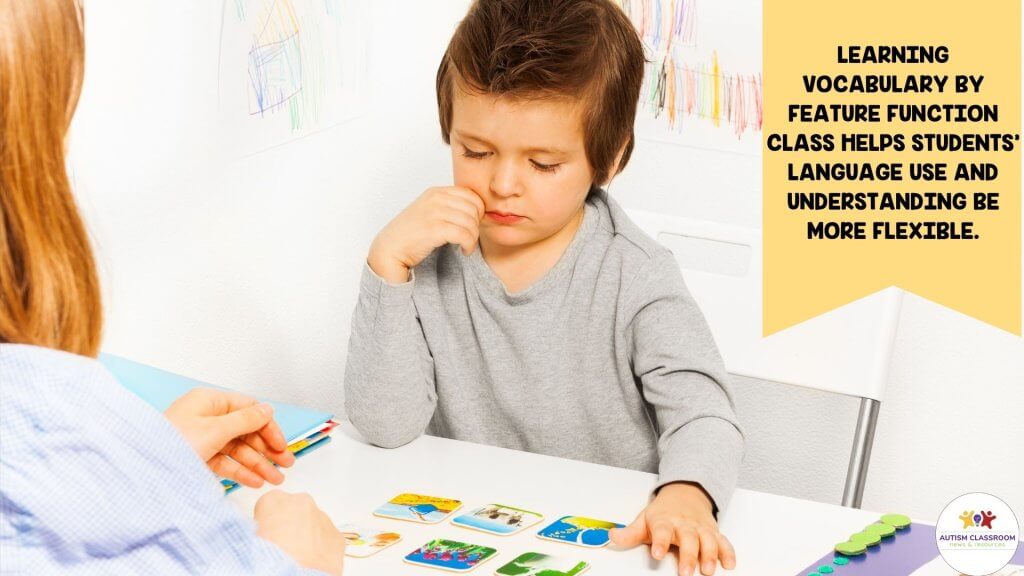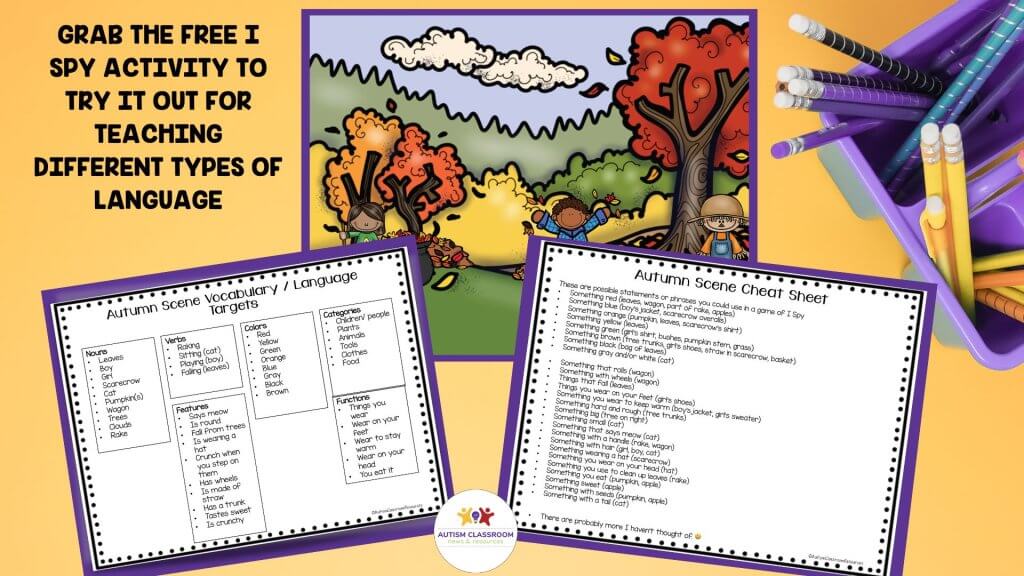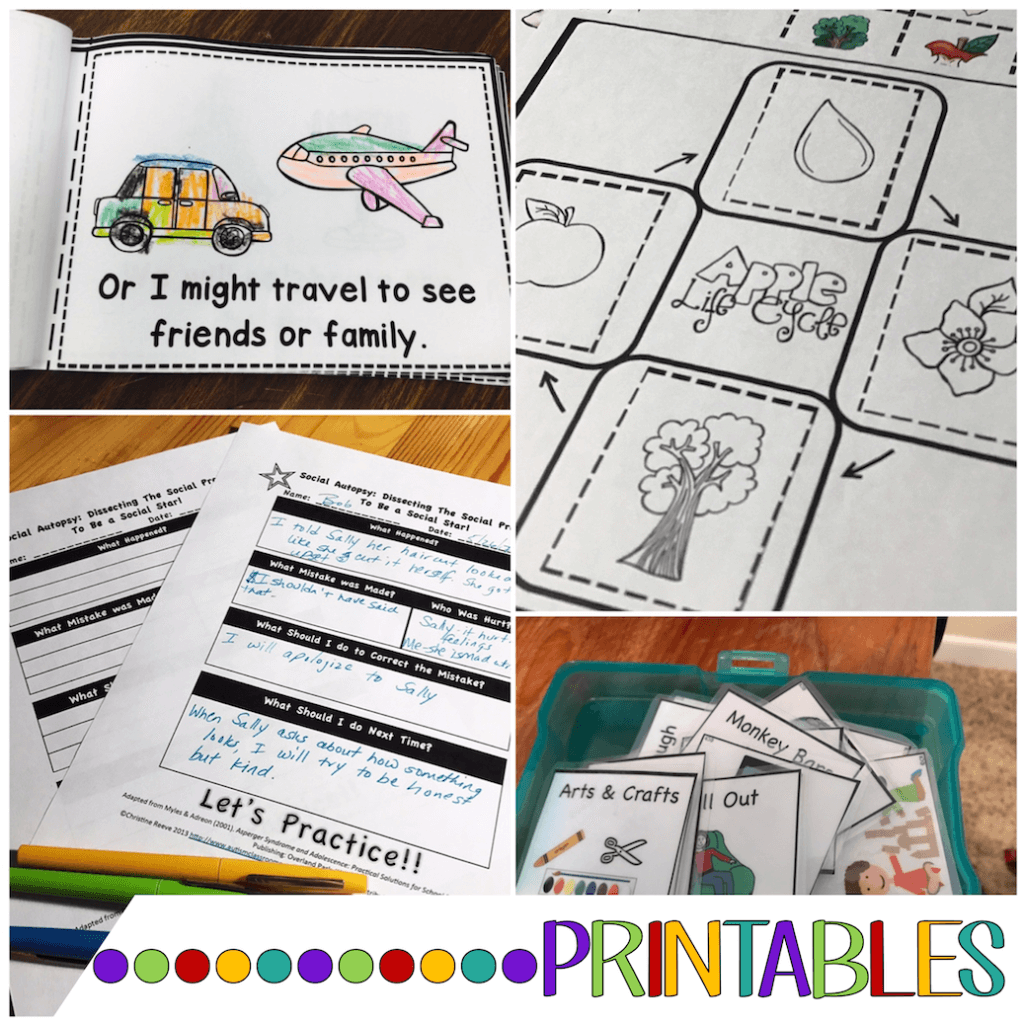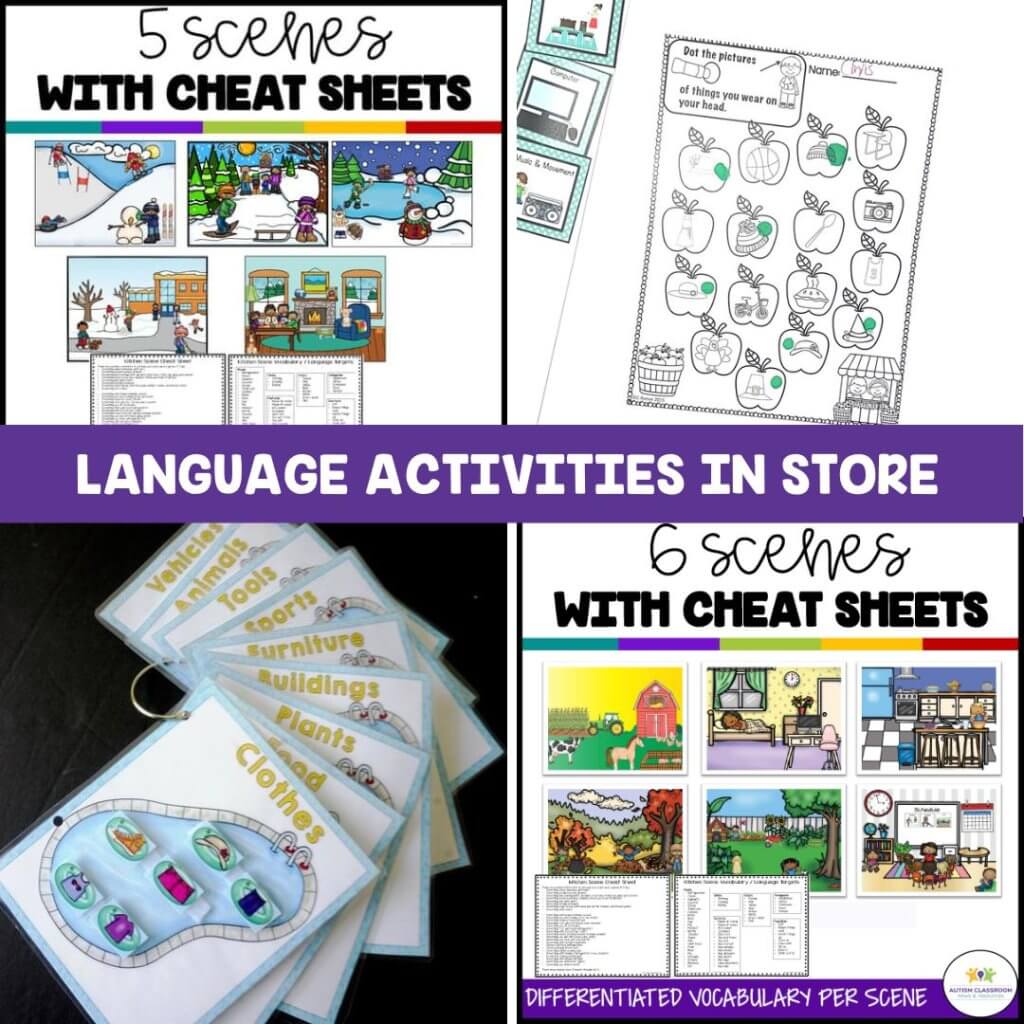Sharing is caring!
Receptive or expressive vocabulary by feature function class (sometimes referred to as RFFC and EFFC) is a common teaching target in applied behavior analysis (ABA) and in speech therapy. ABA programs commonly target this type of language once a student has started to identify common objects or activities.
Expressive feature function class is typically something that is taught once students are able to label or tact items. Receptive feature function class would usually be taught once students are able to receptive identify common items or actions.
Learning FFCs Helps Flexible Language Skills
Learning to use words in a variety of ways is an important element of language development. Particularly for students with autism who often learn and use language in a very concrete rote way.
For instance, I once worked with a student in an ABA program who was learning characteristics (features) of items. Unfortunately, he wasn’t being taught in a way that allowed for much flexibility in responses. So the Starburst candy was always called the “yellow chewy starburst.” It was never the “yellow one” or the “lemon one.” He only learned it one way.

This is a good illustration of why focusing on more effective generalization of feature function class (or characteristics, purpose and category as typical people refer to them) is critical to early intervention programs or any program working on the development of language.
Learning Feature Function Class of Items Helps Increase Language Use
Think about a time when you didn’t know the name of something. Or in my case, think about a time when I can’t recall something’s name that is a common object. LOL
When this happens, we rely on other words and labels to describe what we mean. We use different verbal statements that tell ABOUT the item or activity.
So, when I couldn't remember the name of a flower from our garden, I said, "The one with little blue or purplish flowers that get all over you if you walk too close to it." And my sister replied, "Oh, Plumbago."
I used features (its color, that it sticks to you) and it’s class (flower). By teaching students categories, and adjectives and purposes of items or actions, we enrich their language and allow them to communicate more effectively.
Who Needs Instruction in Feature Function Class?
Early learners with communication and language challenges in early intervention programs typically need FFC work. But students in life skills programs who have limited language comprehension and/or expression can benefit from it as well. Regardless of their cognitive skills, many students from early childhood to high school can benefit from this type of instruction.
3 Easy-to-Use Tools for Fitting This Instruction Into Your Day
With everything else we have to teach, how do we fit this type of language instruction into our day? Luckily there are a number of easy ways to slip it into your small group or your direct instruction with students. Here are 3 sets of activities that can be fun for students in the classroom and keep them engaged.
Use I Spy to Teach Feature Function Class Vocabulary to Students
I love I Spy for a lot of different skills and a number of different reasons. I Spy has often been one of my go-to activities when there is an unexpected lull in the day.
Most of the classrooms I’ve worked in the students weren’t great at waiting. So you always wanted to have something to pull out to fill the team. Because as I’ve talked about in the podcast, it’s a whole lot easier to keep students engaged than to lose the engagement and have to get it back.

Also, you can use I Spy to teach labeling items, receptive identification of items, and feature function class of vocabulary as well. Because traditionally, I Spy focuses on describing something that the other person has to guess what you are talking about. “I Spy something green that grows.” That would be the plant on the windowsill.
If I’m the clue giver, I’m describing something I see. This role is great for students who are working on their expressive language of using feature, function and categories to describe items.
If I’m the guesser, I’m the listener responding with items in the environment like that description. This role is perfect for students still working on their receptive language.
You can grab I Spy Language Kits in my store that already has set pictures with cheat sheets of vocabulary you can talk about in the picture. And there is a free sample you can try in the Resource Library and you can grab that link below. These were designed for distance learning, but they can easily be printed and ready for your small group instruction. Or just pull them out when you have some down time to practice.
Use Picture-Find Activities to Have Students Identify Features, Functions and Class of Items
You can play this game a couple of different ways. You could give language target cards or photos to a set of students and have another one identify the pictures by something other than its name.
Or, you could have worksheets that have pictures and students have to identify which item is described by its feature, function or category. For instance, in the example below from one of my RFFC Kits, the student has to find all the pictures of things with a tail. The great thing about these types of tasks is that they provide their own data collection if the students are marking on the paper. You then have permanent product of their receptive language skills. No pesky data sheet necessary.

You could use these in your direct instruction or discrete trials as a way to keep data while you are asking the student to find items of transportation (class members), something with wheels (feature), something you drive on the road (function). Naming the items without the visual support would have you working on expressive FFCs.
Use Matching and Sorting Activities for Receptive Vocabulary by Feature, Function and Class
Sorting activities are great for teaching receptive vocabulary to young learners. Commonly we often use file folder activities or sorting mats for students to classify items by category.

But we can also sort by characteristic or feature or sort by function as well. Instruct, “Give me all the things we eat with” from a set of picture cards. And the student gives you the spoon, the fork, a cup, and a plate. They don’t give you the car, the cat, the shoe, or the shirt.
Similarly we can do that same task with features. You say, “Give me all the pictures of items that are blue.” And the student gives you the blueberry, the blue shoe, the blue pencil. They don’t give you the red pencil, the strawberry or the pink shirt.
It’s helpful to have the student have multiple items to identify so they don’t begin to think there is always just one answer. If I told someone to go pick some flowers from my garden or that I needed some blue flowers for the arrangement I’m making, I wouldn’t want them to think they should only bring 1 flower.
Multiple items also makes it less likely that the student will get stuck on one particular item. And it allows you to mix up your instructional targets more effectively so the student learns more flexibly.
Resources for Teaching Feature Function Class
There are tons of ways to integrate feature function class instruction into common everyday activities in addition to those described above. If you want to try one of the strategies above, grab the free items below from the Resource Library, and let me know how they work. If they work well for you, grab the fuller products from my store.









